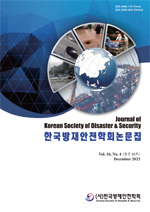산지지역 개발에 의한 산사태 위험 분석
Landslide Risk Analysis due to Development of Mountain Area
- 한국방재안전학회
- 한국방재안전학회 논문집
- 16권 4호
-
2023.1267 - 74 (8 pages)
-
DOI : 10.21729/ksds.2023.16.4.67
- 25

본 연구에서는 산지 지역의 개발 예정지에 대하여 산사태의 발생 위험성을 분석 하였다. 개발 예정지의 위치를 고려하여 사면에서의 위험성과 계류에서의 위험성을 구분하여 현장조사를 수행하였고, 산사태의 발생 위험성 평가 기준은 산림청고시 제2023-10호 산사태 발생 우려지역 조사 및 취약지역 지정 ‧ 관리 지침의 평가표를 이용하였다. 사면13개소와 계류 11개소에 대하여 각각 위험도를 평가한 결과 사면 2개소, 계류 2개소에서 위험한 것으로 조사되었다. 위험한곳으로 조사된 지역에 대하여 토석류 피해가 발생할 것으로 예상되어 수치시뮬레이션을 이용하여 토석류 확산 범위를 분석하였다. 예상되는 토석류는 유역 하부에 위치한 도로 및 건물에 영향이 있을 것으로 시뮬레이션되어, 피해를 최소화 하기 위한 재해방지시설이 필요할 것으로 판단하였다. 이러한 정보는 산지 개발을 수행하기 전 사전 재해영향성 검토에 활용될 수 있을 것으로 예상된다.
In this study, the risk of landslides was analyzed for planned development sites in mountainous areas. Field survey was conducted on the research area with the slope and valley site. The criteria for evaluating the risk of landslides in the field survey were based on the risk assessment table of the Korea Forest Service Notice No. 2023-10. The research area has 13 slopes and 11 valleys. As a result of evaluating the risk area, two slopes and two valley were found to be dangerous sites in each. Numerical simulation was performed on the investigated risk areas to predict the spread of damage. The debris flow was simulated to have an affect on roads and buildings located in the lower part of the basin, and it was determined that a disaster prevention facility was nacessary to minimize damage. This information can be used to determine the impact of disasters before carrying out mountain development.
1. 서론
2. 본론
3. 결론
Acknowledgments
References
(0)
(0)